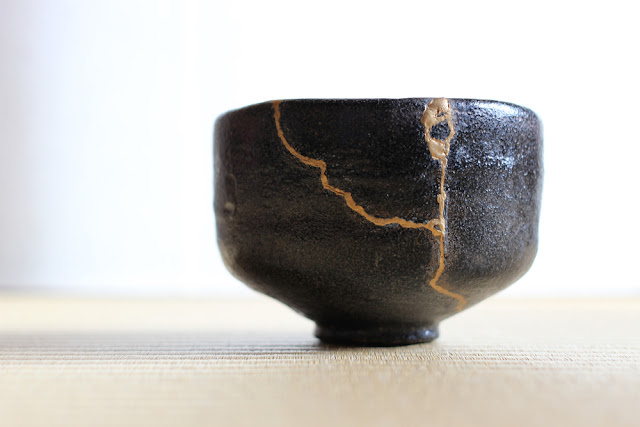Kintsugi: the cool way to repair broken pottery
Through Kintsugi, a broken object acquires diverse perspectives both from an artistic and symbolic point of view - it’s the Japanese technique of preserving the sentimental value of broken ceramics during repairs, by literally giving them new life, when they assume new form.
From an aesthetic standpoint, it’s creatively highlighting where the damage occurred. However, figuratively, the symbolic interpretation of picking up the broken pieces espouses a different meaning altogether. Our imperfections, scars and wounds that we acquire in the course of time are not meant to be hidden, but rather to be proudly displayed.
Kintsugi is a combination of two words where kin designates gold, while tsugi means to join. This involves using a special lacquer mixed with mainly gold or silver to repair broken ceramics. This 500-year-old Japanese technique seeks to accentuate where breakage has occurred.
This is not an effort simply geared to put the damaged piece to their original state. On the contrary, the repair is consciously meant to leave visible traces, thereby becoming an art that highlights the flaw.
Finding beauty in broken things is the spirit of wabi-sabi
The Kintsugi practice, is embedded in the Japanese wabi-sabi tradition of finding beauty in imperfections. To this end, an object is considered wabi-sabi, if it provokes a feeling of profound melancholy and a divine yearning. However, it is not just a matter of arbitrarily attaching religious value to any ceramic object. It’s much deeper than that.
Transition from original to repaired
The pieces, once broken, are effortlessly joined, while supplementing each other to a new whole. Moreover, the new object with the golden patches, is in no way inferior to the beauty of the original.
However, there is a caveat. Like in many Japanese works of art, there is a sentimental value that inspires it. According to Muneaki Shimode, a prominent Kintsugi master from Japan. The outward appearance of the object is not an end in itself but what is vital, is the exquisiteness plus meaning the observer experiences through the object. In essence, there is a story behind those objects. These two aesthetics elements must be intertwined together.
We should not hide our broken self during and after restoration
Those who may not be familiar with eastern philosophy, they are bound to discover some counter intuitive narratives, that may not be coherent with their world views. Kintsugi art is no different in this aspect. You see a leaking bowl does not signify an end of its utility, far from it.
Perhaps, there are missing a few parts that seem to be an existential ingredient for the functioning of your life. But look close enough, you will find there are other complementary building blocks to fill in the cracks. Go along with these changes and blend in. Build something unique, without drowning it and masking the traces of the changes you have made.
Resource By : https://lexigo.com/blog/kintsugi-the-cool-way-to-repair-broken-pottery
From an aesthetic standpoint, it’s creatively highlighting where the damage occurred. However, figuratively, the symbolic interpretation of picking up the broken pieces espouses a different meaning altogether. Our imperfections, scars and wounds that we acquire in the course of time are not meant to be hidden, but rather to be proudly displayed.
Kintsugi is a combination of two words where kin designates gold, while tsugi means to join. This involves using a special lacquer mixed with mainly gold or silver to repair broken ceramics. This 500-year-old Japanese technique seeks to accentuate where breakage has occurred.
This is not an effort simply geared to put the damaged piece to their original state. On the contrary, the repair is consciously meant to leave visible traces, thereby becoming an art that highlights the flaw.
Finding beauty in broken things is the spirit of wabi-sabi
The Kintsugi practice, is embedded in the Japanese wabi-sabi tradition of finding beauty in imperfections. To this end, an object is considered wabi-sabi, if it provokes a feeling of profound melancholy and a divine yearning. However, it is not just a matter of arbitrarily attaching religious value to any ceramic object. It’s much deeper than that.
Transition from original to repaired
The pieces, once broken, are effortlessly joined, while supplementing each other to a new whole. Moreover, the new object with the golden patches, is in no way inferior to the beauty of the original.
However, there is a caveat. Like in many Japanese works of art, there is a sentimental value that inspires it. According to Muneaki Shimode, a prominent Kintsugi master from Japan. The outward appearance of the object is not an end in itself but what is vital, is the exquisiteness plus meaning the observer experiences through the object. In essence, there is a story behind those objects. These two aesthetics elements must be intertwined together.
We should not hide our broken self during and after restoration
Those who may not be familiar with eastern philosophy, they are bound to discover some counter intuitive narratives, that may not be coherent with their world views. Kintsugi art is no different in this aspect. You see a leaking bowl does not signify an end of its utility, far from it.
Perhaps, there are missing a few parts that seem to be an existential ingredient for the functioning of your life. But look close enough, you will find there are other complementary building blocks to fill in the cracks. Go along with these changes and blend in. Build something unique, without drowning it and masking the traces of the changes you have made.
Resource By : https://lexigo.com/blog/kintsugi-the-cool-way-to-repair-broken-pottery

Comments
Post a Comment